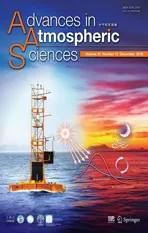A 31-year Global Diurnal Sea Surface Temperature Dataset Created by an Ocean Mixed-Layer Model
2018-10-16XiangLITiejunLINGYunfeiZHANGandQianZHOU
Xiang LI,Tiejun LING,Yunfei ZHANG,and Qian ZHOU
Key Laboratory of Research on Marine Hazards Forecasting,National Marine Environmental Forecasting Center,State Oceanic Administration,Beijing 100081,China
ABSTRACT A dataset of hourly sea surface temperature(SST)from the period 1 January 1982 to 31 December 2012,and covering the global ocean at a resolution of 0.3°×0.3°,was created using a validated ocean mixed-layer model(MLSST).The model inputs were heat flux and surface wind speed obtained from the Coupled Forecast System Reanalysis dataset.Comparisons with in-situ data from the Tropical Atmosphere Ocean array and the National Data Buoy Center showed that the MLSST fitted very well with observations,with a mean bias of 0.07°C,and a root-mean-square error(RMSE)and correlation coefficient of 0.37°C and 0.98,respectively.Also,the MLSST fields successfully reproduced the diurnal cycle of SST in the in-situ data,with a mean bias of −0.005°C and RMSE of 0.26°C.The 31-year climatology revealed that the diurnal range was small across most regions,with higher values in the eastern and western equatorial Pacific,northern Indian Ocean,western Central America,northwestern Australia,and several coastal regions.Significant seasonal variation of diurnal SST existed in all basins.In the Atlantic and Pacific basins,this seasonal pattern was oriented north–south,following the variation in solar insolation,whereas in the Indian basin it was dominated by monsoonal variability.At the interannual scale,the results highlighted the relationship between diurnal and interannual variations of SST,and revealed that the diurnal warming in the central equatorial Pacific could be a potential climatic indicator for ENSO prediction.
Key words:SST,diurnal cycle,mixed-layer model,climatic variation
1.Introduction
Air–sea interaction is an important process affecting climatic variation.The sea surface temperature(SST)is one of the most important parameters governing this interaction(Fairall et al.,1996).Typically,SST varies in four different frequency bands:the diurnal cycle,a 20–40-day band,the annual cycle,and a 2–7-year cycle(Kessler et al.,1996).Thereinto,the diurnal cycle,which is caused by solar radiation and Earth’s rotation,is one of the dominant variations in SST,and the diurnal amplitude of SST can even exceed several degrees in extreme cases(Stramma et al.,1986;Flament et al.,1994;Weller and Anderson,1996;Soloviev and Lukas,1997;Ward,2006;Kawai and Wada,2007;Bellenger and Duvel,2009).
Recently,many researchers have paid special attention to air–sea interaction on the SST diurnal cycle(DSST).Realistic simulation of DSST is helpful for reproducing the seasonal variation of SST(Chen et al.,1994;Li et al.,2001;Clayson and Chen,2002;Bernie et al.,2005;Mosedale et al.,2005;Vitart et al.,2007),and Madden–Julian Oscillation predictability was improved when DSST was considered in a general circulation model(Woolnough et al.,2007).Meanwhile,the absence of the SST diurnal signal has been shown to result in an average flux bias of about 4.5 W m−2in the global domain,and an increase to more than 200 W m−2in certain locations(Clayson and Bogdanoff,2013).Also,the absence of diurnal solar forcing in air–sea coupled models with a coarse coupling frequency has been shown to cause several undesirable consequences,including large El Niño–Southern Oscillation(ENSO)variability,cool SSTs in the equatorial Pacific,and the disappearance of deepcycle turbulence(Danabasoglu et al.,2006).In addition,replacing the diurnal SST variability with a similar mean SST in a coupled global climate model can result in a systematic decrease in ENSO amplitude(Masson et al.,2012).
Due to the importance of DSST,increasing numbers of studies are focusing on analyzing the climatological characteristics of DSST,which can be achieved using in-situ data,satellite observations,or models.To date,a great number of diurnal warming events have been observed in-situ(Stramma et al.,1986;Fairall et al.,1996;Clayson and Weitlich,2005;Ward,2006).Although in-situ measurements may contain uncertainties(Kennedy,2014),the best(i.e.,high frequency and quality)SST and skin SST time series are obtained from in-situ radiometers,moorings,and drifting buoys.Based on hourly data from drifting buoys(Shenoi et al.,2009),Kennedy et al.(2007)created a global 15-year climatology of in-situ DSST variations between 1990 and 2004,the results of which agreed well with an empirical model derived from moored-buoy data.However,the spatial coverage provided by drifting buoys is non-uniform and sparse,and they cannot provide long-term,high-frequency,spatially homogeneous SST observations over large areas.
With the development of satellite remote sensing,satellite-borne radiometers have provided extensive and continuous spatial coverage of SST since the 1980s.Accordingly,many datasets and studies of diurnal SST variation have been created for regional and global domains using satellite observations.For example,the temporal and spatial patterns of diurnal warming in the Bay of Biscay between 1988 and 1990 were obtained from National Oceanic and Atmospheric Administration(NOAA)Advanced Very High Resolution Radiometer(AVHRR)data,revealing that the largest diurnal warming occurred in summertime around coastal areas,with the most extreme values reaching up to 6°C(Huang et al.,1999).Gentemann et al.(2003)collected multi-source satellite data over several years prior to 2001 to derive daily global maps of diurnal warming.Their results revealed that the onset of warming began as early as 0800 LST(local standard time)and peaked near 1500 LST,with an extreme magnitude of 2.8°C.Stuart-Menteth et al.(2003)analyzed 10 years(1987–90 and 1993–98)of infrared satellite data from AVHRR and concluded that large regions in the tropics and midlatitudes are frequently susceptible to diurnal warming each year.Tanahashi et al.(2003)showed that instruments placed in geostationary orbit,such as the Visible and Infrared Spin Scan Radiometer and Geostationary Meteorological Satellite,can provide the necessary sampling of the diurnal cycle,although their field of view can be obstructed by clouds(Kennedy et al.,2007).Merchant et al.(2008)studied DSST in the western European shelf seas and Mediterranean using hourly satellite data over a five-month period in 2006.They characterized near-surface ocean diurnal warm-layer events and inferred that extreme amplitudes of DSST are related to low wind speeds sustained from early morning to midafternoon.Marullo et al.(2010)generated an SST dataset with a 3-h interval and 25-km resolution over a 2-yr period(2006–07)between 30°S and 30°N of the tropical Atlantic region by using geostationary satellite observations as the diurnal signal source.The validation showed this SST dataset to be almost bias-free.Eastwood et al.(2011)studied SST diurnal warming events during June and July 2008 in the Arctic and revealed that these events normally occur in persistent low-wind conditions,and occur more frequently in shallow waters than deep waters.Karagali and Høyer(2014)generated six years of SST data in the Atlantic Ocean and European seas by using hourly SST observations from the geostationary Spinning Enhanced Visible and Infrared Imager(SEVIRI);the validations showed the bias to be −0.07°C and the standard deviation 0.51°C.Castro et al.(2014)compared Argo float and SEVIRI satellite observations and concluded that satellite data can represent diurnal warming events very well.Tu et al.(2016)used four years of hourly geostationary satellite SST data to characterize the DSST in the China seas and the northwestern Pacific Ocean.The mean bias was found to be approximately −0.2°C,and the standard deviation 0.6°C,through validation with drifting buoy measurements.
The amplitude of DSST can be estimated using an empirical model with a homogeneous grid and inputs of solar radiation,wind and SST.Kawai and Kawamura(2005)generated a DSST product covering(60°S–60°N,80°E–160°W),with a resolution of 0.25°,from 1998 to 2001,that had a root-meansquare error(RMSE)of 0.2°C–0.3°C and indicated some differences in the diurnal amplitude of SST between El Niño and La Niña periods.Qin et al.(2007)created another dataset for the same region but covering the period 1 January 1996 to 30 June 2001 to investigate hot events associated with extreme SSTs of around 30°C.Clayson and Weitlich(2007)generated a dataset consisting of daily diurnal warming values derived from daily averaged wind speed determined from Special Sensor Microwave Imager data and International Satellite Cloud Climatology Project data to analyze the climatic variations in the global tropical area.
Most of the studies mentioned above focused on the pattern of DSST amplitude.Without an hourly SST dataset,it can be difficult to reproduce the warming thresholds,peak values,and timings.Although there are some hourly SST datasets generated from satellite data,their temporal and spatial coverage is limited,and cloud introduces uncertainty.Bernie et al.(2007)obtained a global view of SST diurnal warming using an ocean general circulation model with 300 vertical levels and forced by ERA-40 data,but such an approach would be too costly for long-term climate research.Karagali and Høyer(2014)pointed out that future work should focus on reproducing the observed diurnal variability using a 1D turbulence model,but no relevant studies have yet been reported.
Ling et al.(2015)developed a 1D upper-ocean mixedlayer model with good performance in simulating DSST and skin SST.In the present study,we produced a 31-year hourly SST dataset by using this mixed-layer model(MLSST)and evaluated it with in-situ data.We then used the dataset to study continuous diurnal SST variations at the global scale.
The remainder of the paper is organized as follows:The setup of the mixed-layer model and the dataset are described in section 2.The validation of the data is presented in section 3.In section 4,the characteristics of DSST variability are described.And finally,a discussion and conclusions are provided in section 5.
2.Model and data
2.1.Mixed-layer model
In this study,we used the upper-ocean mixed-layer model developed by Ling et al.(2015),which is a second-order tur-bulence mixed-layer model based on that of Noh et al.(2011).The fundamental equations of this model are the prognostic equations for potential temperature,mean velocity,salinity,and turbulent kinetic energy(TKE).The model incorporates improvements that addressed the shortcomings of the original model in reproducing large DSST amplitudes.
DSST is very sensitive to wind stress and incident shortwave solar radiation.To prevent excessive variation in the topmost model layer,momentum penetration and solar penetration schemes are included in this model.
The momentum flux is distributed vertically as

where τsis the wind stress at the surface,his the mixedlayer depth,andzis the vertical height from 0 toh.During model integration,the mixed-layer depths are diagnosed at each time step with gradient buoyancy and TKE thresholds,and varied with horizontal space.
Solar penetration follows a two-band scheme developed by Kara et al.(2005).The scheme is parameterized as

whereQsol(z)is the total shortwave radiation at depthz,κPARis the attenuation of photosynthetically active radiation,and γ=max(0.27,0.695−5.7κPAR)is the proportion of photosynthetic irradiance to total incident irradiance.
We used a prognostic skin temperature scheme developed by Zeng and Beljaars(2005)in this model to solve the coolskin and warm-layer effects.Furthermore,a relaxation term was added to the topmost layer of the temperature prognostic equation to contain the long-term climate drift caused by the inability of the 1D model to represent horizontal and vertical advection terms.In the relaxation term,the previous SST daily mean difference between the observation and model is utilized with a relaxation coefficient of 8640 s.This helps to prevent an excessive impact of the observed value on the simulated DSST,since the relaxation term does not change at each time step,thus avoiding any significant reduction in the diurnal amplitude.
Finally,to ensure model accuracy, two numerical schemes were applied in the model to improve computational effi-ciency;namely,stretching of the vertical grid,and semiimplicit time integration.The former scheme reduces the model levels,and the latter improves both the accuracy and efficiency.
To achieve global hourly SST data,we extended this 1D model to 2D applications through a framework program.The major functions of this program included:inputting grid atmospheric variables and outputting grid ocean variables in NetCDF format;splitting the whole domain into several subdomains with Message-Passing-Interface(MPI)support;and calling the 1D model as subroutines within the input and output steps.In order to ensure the stability of numerical computation,all calculated variables were saved in 10-day intervals for the restart run.
2.2.Data
2.2.1.In-situ data
The Tropical Atmosphere Ocean(TAO)array consists of more than 70 buoys that lie in the tropical Pacific(8°S–8°N,137°E–95°W).The buoys were selected because they provide long-term and continuous SST data.Here,we selected 55 buoys from 2000 to 2012,and downloaded their data from the TAO Project website(http://www.pmel.noaa.gov/tao/disdel/).The accuracy of the SST measurements is±0.02°C(Payne et al.,2002).
The National Data Buoy Center(NDBC)(Hamilton,1986)collects data from hundreds of buoys worldwide.The NDBC website provides both real-time and historical observational buoy data.These provide standard meteorological data,solar radiation,and continuous wind measurements.Here,we selected 13 buoys along the U.S.coastal regions covering the period 2010–12.Throughout the analysis,around 55%of these had DSST amplitudes greater than 0.58°C,and around 27%greater than 1.8°C.
Figure 1 shows the locations of the buoys selected for this study,and these in-situ data serve as high-quality validation data to assess the performance of the MLSST simulation.
2.2.2.Model data
The Coupled Forecast System Reanalysis(CFSR)(Saha et al.,2010)is the latest generation of the National Centers for Environmental Prediction(NCEP)reanalysis.It provides data at a 0.3°×0.3°spatial resolution and a 6-h temporal resolution,covering the period 1979–2010.On 30 March 2011,the NCEP upgraded the system to version 2(CFSv2;Saha et al.,2014),and the period of coverage to the present day.To match with the model simulation period,we selected CFSR data from 1982 to 2010 and CFSv2 data from 2011 onward.Although there are some biases with respect to heat flux and surface wind stress in CFSR,they are smaller compared with other reanalysis data(Xue et al.,2011;Kumar and Hu,2012;Stopa and Cheung,2014).This dataset was used as the atmospheric forcing to drive the mixed-layer model.

Fig.1.Locations of the TAO and NDBC stations used in this study.
The Optimum Interpolation Sea Surface Temperature(OISST)(Reynolds et al.,2007)is an analysis product constructed by NOAA.The data are produced by combining observations from different platforms(satellites,ships,buoys etc.)onto a regular global grid.Here,we used the AVHRR data with a 0.25°spatial resolution and daily temporal resolution.AVHRR has the longest record(from late 1981 to the present day)of SST measurements.The OISST data were used as the observations for the relaxation method to avoid long-term climate drift.
3.Validation of MLSST
To evaluate the MLSST simulation’s accuracy,we compared the MLSST simulation with hourly moored buoy measurements from TAO and NDBC.The 68 buoys provided 4 855 455 matched-up SST values over the period 2000–12,and we compared all these matchups between the MLSST and TAO/NDBC buoy data.Figure 2 compares the SST time series between the MLSST simulation and TAO/NDBC buoy data from 1 January 2010 to 31 December 2010.Apart from a few spikes observed in the buoy data and MLSST,the two time series at these buoy positions are qualitatively coherent and exhibit evident diurnal signals,together with high seasonality in the SST values at different buoy locations.In both the Northern Hemisphere and Southern Hemisphere,SST is higher in local summer and lower in local winter.Generally,the biases range from −0.26°C to 0.40°C,with most around−0.1°C to 0.1°C among the 68 selected buoys;the RMSE ranges from 0.16°C to 0.69°C.Correlation coefficients at each of the buoy locations range from 0.46 to 0.99,with only one correlation coefficient less than 0.5 and more than 69%above 0.90.Meanwhile,all correlation coefficients are above the 99%confidence level.However,higher correlations dominate the NDBC buoy locations,whereas the correlations related to TAO buoy locations tend to be slightly lower.
Figure 3 shows a scatterplot of the MLSST and TAO/NDBC buoy matchups.The MLSST simulations are evenly distributed around the line of perfect agreement,with relatively little dispersion.The overall statistics resulting from the comparison between the MLSST and buoys(4 855 455 matchups)show a near-zero bias(0.07°C),a correlation coefficient of 0.98,and an RMSE of 0.37°C,demonstrating the high accuracy of the MLSST simulation.
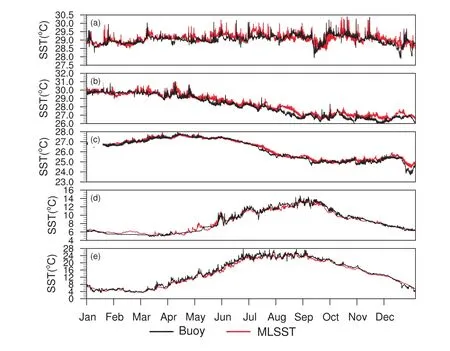
Fig.2.Comparison of SST time series between TAO/NDBC and MLSST from 1 January 2010 to 31 December 2010 for selected buoy stations:(a)T5N165E(5°N,165°E);(b)T0N180W(0°N,180°W);(c)T8S125W(8°S,125°W);(d)46076(59.498°N,147.983°W);(e)44009(38.461°N,74.703°W).
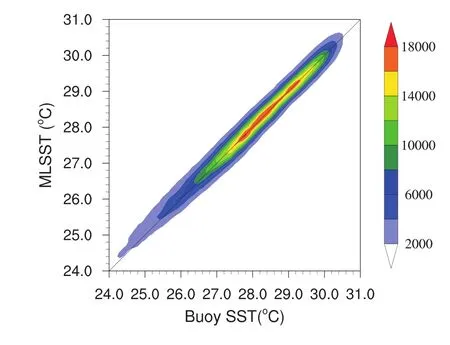
Fig.3.Scatterplot between SSTs measured by TAO/NDBC buoys and the MLSST simulation.The color scale-bar indicates the number of records(total:4 855 455).
Figure 4 compares the DSST time series between the TAO/NDBC buoys and MLSST simulation from 1 January 2010 to 31 December 2010 for selected buoy locations.The two time series derived from the buoy locations are qualitatively coincident,with some spikes observed in both the buoy and MLSST simulation.Specifically,the MLSST simulation cannot reproduce the extreme diurnal SST values at the location(38.461°N,74.703°W)of buoy 44009.The average biases and correlation coefficients of DSST between the MLSST and in-situ data for each buoy location were calculated,and no regional biases were found.The biases range from −0.32°C to 0.08°C,with a mean bias of−0.005°C and average RMSE of 0.26°C.The correlations at each of buoy location range from 0.31 to 0.76,with a mean correlation of 0.63 and most correlations above 0.50.Comparatively,the NDBC correlations tend to be slightly lower,whereas higher correlations dominate the TAO buoy locations.
The 68 buoys provide 89153 diurnal warming values from 1January 2000 to 31 December2012 for comparison with the MLSST values.Though rare,several DSSST amplitude values are greater than 3.0°C in the buoy dataset(Fig.5a);however,there are no values greater than 2.58°C in the MLSST simulation(Fig.5b).DSST amplitude errors in the MLSST simulation may be associated with several different factors.One is the uncertainty of shortwave radiation flux and surface wind stress in CFSR(Xue et al.,2011;Kumar and Hu,2012),and another is the mixed-layer model itself.Both the buoy data and MLSST simulation have a similar median DSST value of around 0.32°C,and the mean values for both datasets are also similar(0.42°C).These results fit very well with Clayson and Weitlich(2007).
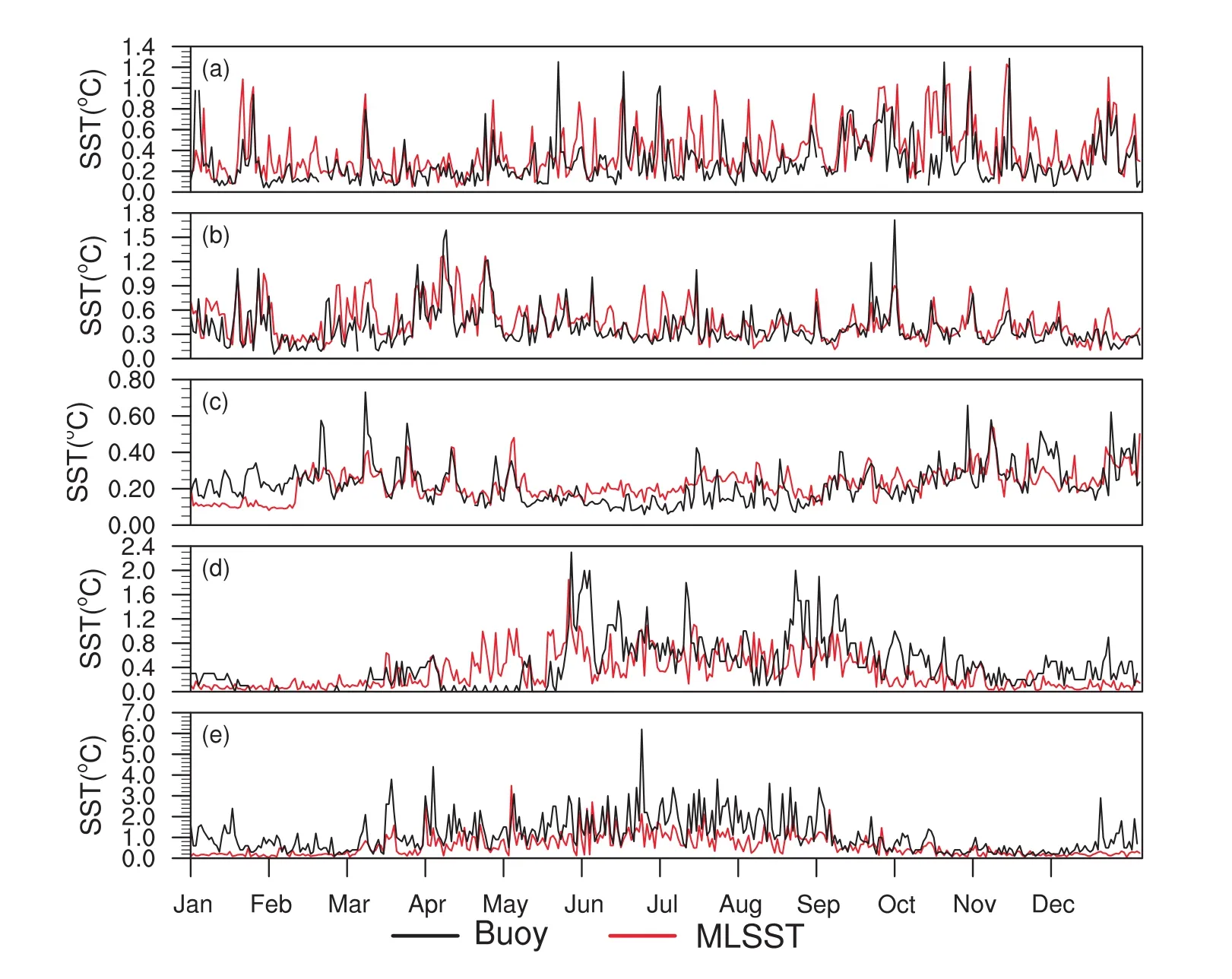
Fig.4.Comparison of the DSST time series between buoy observations and MLSST from 1 January 2010 to 31 December 2010 at selected buoy positions:(a)T5N165E(5°N,165°E);(b)T0N180W(0°N,180°W);(c)T8S125W(8°S,125°W);(d)46076(59.498°N,147.983°W);(e)44009(38.461°N,74.703°W).
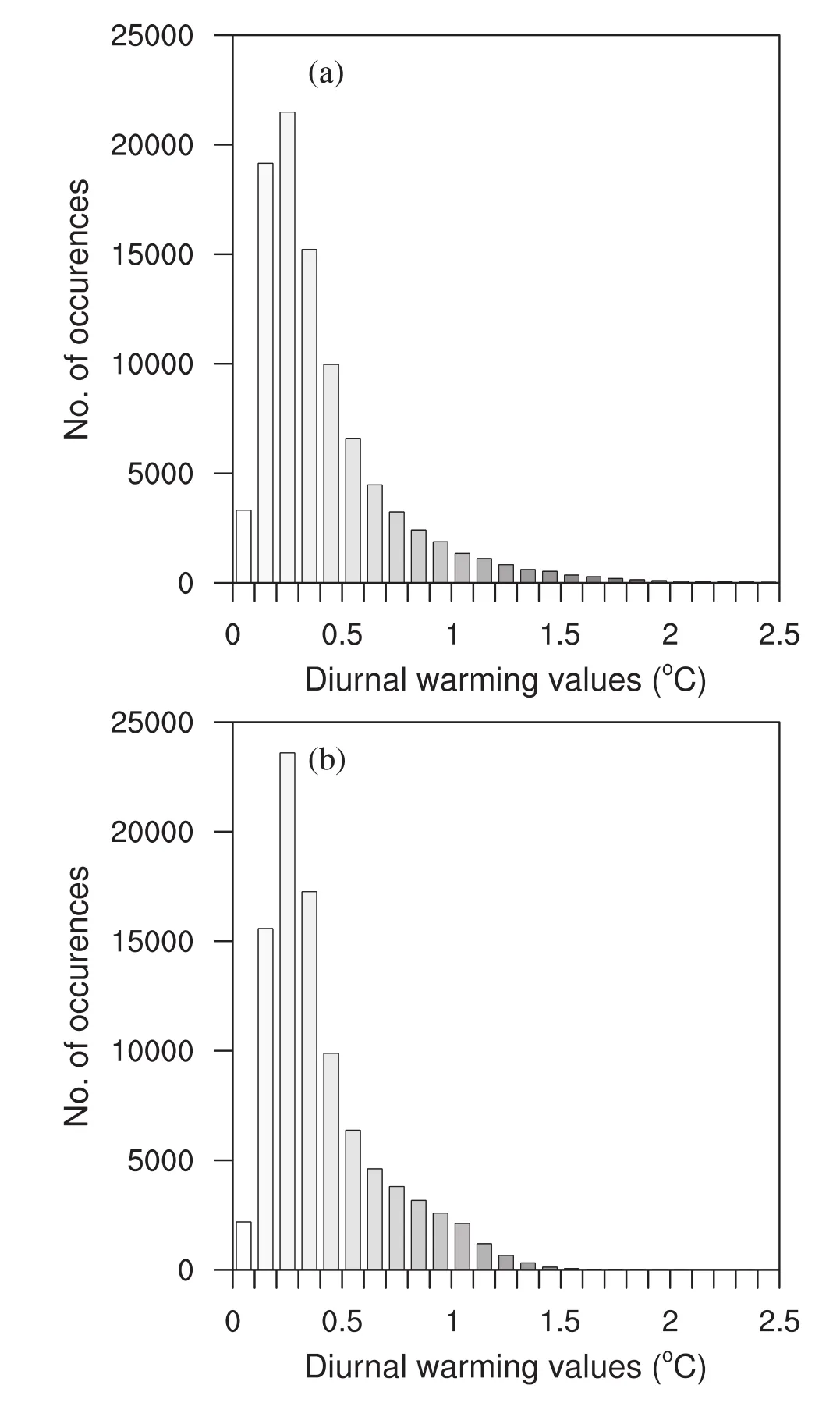
Fig.5.Histogram of diurnal warming values from the(a)TAO/NDBC buoys and(b)MLSST.
The ability of the MLSST simulation in reproducing the monthly diurnal cycle is another factor to estimate the accuracy.Because local surface solar radiation is a major factor driving the DSST cycle,and closely related to the local time,we grouped the MLSST simulation as a function of local time and then averaged for each month.Figure 6 presents the monthly mean diurnal cycle anomaly by binning all the matched-up TAO/NDBC buoy data and MLSST simulations at hourly intervals.Generally speaking,the amplitude and shape of the MLSST diurnal cycle(red line)is comparable to the buoy pattern(black line).The magnitude of the monthly mean diurnal cycle anomaly in the MLSST simulation is greater than that observed.The monthly diurnal cycle anomaly from the MLSST simulation exhibits almost the same peak time as the observations,between 1500 and 1600 local sidereal time,but with a slight lag.The greater magnitude in the MLSST simulation can largely be explained by the diurnal cycle of the solar radiation anomaly.The phase shift,meanwhile,which is mainly dominated by the shortwave radiation used in the model integration,is one hour earlier.
4.Climatological characteristics of DSST variation
After evaluating the accuracy of the MLSST simulation,we now explore this dataset to reveal some of the climatological characteristics associated with DSST variations.
4.1.Climatology
The climatology of DSST over the entire 31 years of the MLSST simulation clearly highlights regions that differ substantially from the mean(Fig.7a).The 31-year climatology reveals that the diurnal range is small across most regions,with higher values in the eastern and western equatorial Pacific,northern Indian Ocean,western Central America,northwestern Australia,and several coastal regions.Values close to 0.8°C are evident in some localized regions.These regions are mainly around the equator and can best be explained by the wind speed variability across these basins,while the smaller average DSST values along the Intertropical Convergence Zone(5°N)are caused by the lower values of peak solar radiation associated with the convective clouds that develop there.
The frequency of occurrence of diurnal warming events(of the order of several°C),with amplitudes greater than 0.5°C and 1.0°C,are shown in Figs.7b and c.These diurnal warming events have similar spatial patterns to the averaged DSST.The amplitude is greater than 0.5°C(i.e.,an extreme warming event)on more than 60%of days over the eastern and western equatorial Pacific,northern Indian Ocean,northwestern Australia,and several coastal regions.Over western Central America,the amplitude is greater than 0.5°C on more than 80%of days.Diurnal warming events with amplitude greater than 1.0°C are not unusual,occurring on more than 30%of days over the western equatorial Pacific and western Central America.Diurnal warming signals greater than2.0°C are much rarer(not shown).
The long-term trend of DSST variation is shown in Fig.8.Over the 31-year study period,the main regions of enhanced DSST are around the equator, with an increasing trend of 0.005°C yr−1in the western equatorial Pacific.Declining DSST is found in the eastern Pacific and eastern Atlantic,with a trend exceeding −0.005°C yr−1in the eastern equatorial Atlantic.
4.2.Seasonal variability
The amplitude of diurnal SST variability is significantly seasonally dependent according to observations(Stuart-Menteth et al.,2003;Clayson and Weitlich,2007;Kawai and Wada,2007).The seasonal cycle of DSST is obvious in the 31-year average for each month(Fig.9).A significant seasonal oscillation can be found among each month in the Pacific,Atlantic and Indian basins.In addition,the whole North Indian Ocean experiences a seasonal variability of DSST,with peaks of 0.9°C in April and troughs of less than 0.2°C in July.In general,the diurnal variation is relatively large in the tropical area.
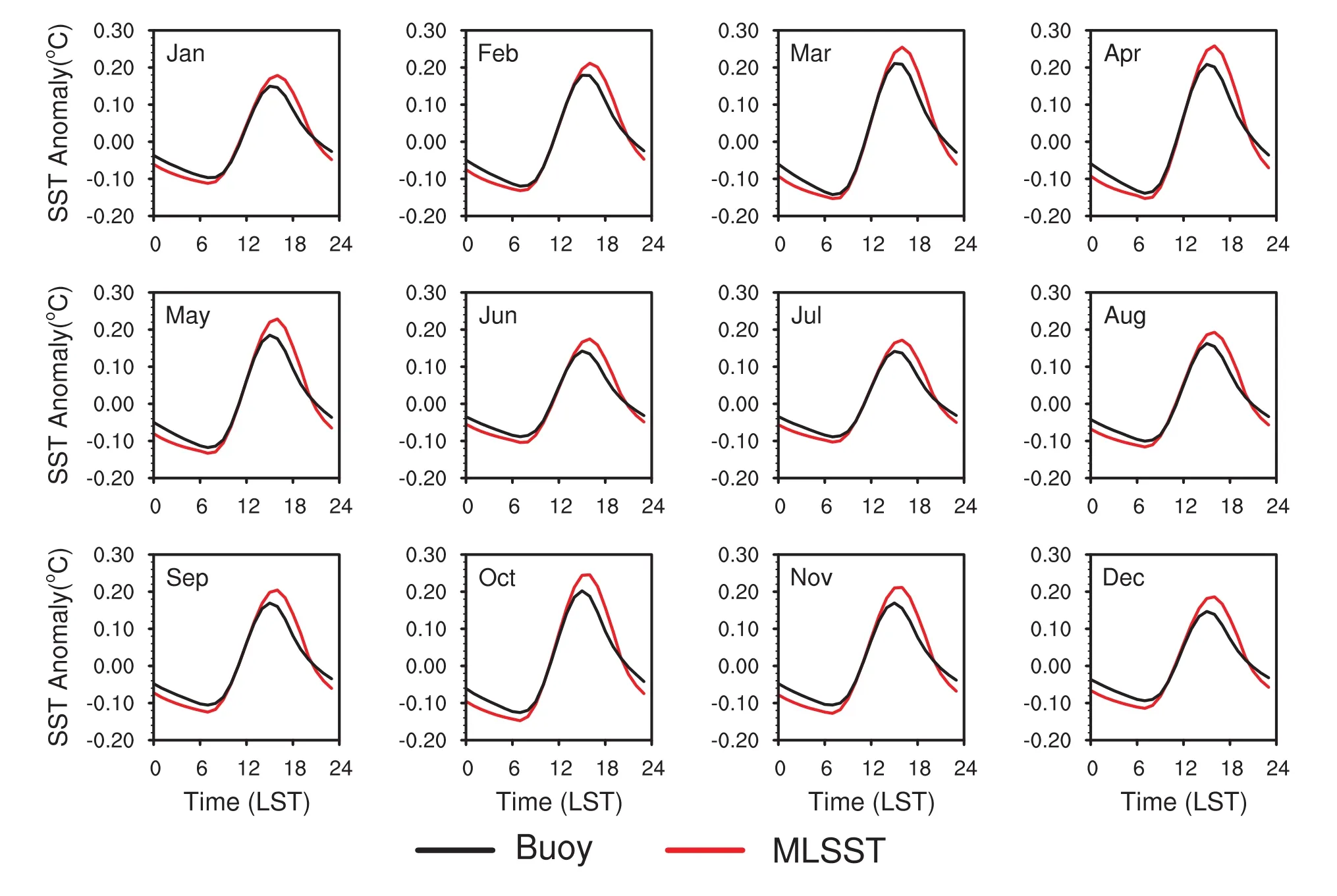
Fig.6.Comparison of monthly mean DSST anomalies between the TAO/NDBC buoy data and MLSST simulation from 1 January 2000 to 31 December 2012 over all buoy positions.
The cause of DSST seasonal variation varies among basins.The seasonal variability of DSST in the Pacific and Atlantic is closely related to the seasonal variability of shortwave solar radiation from north to south due to Earth’s rotation.Besides the seasonal variability of shortwave solar radiation,the tropical convection associated with the Indian summer monsoon is the dominant contribution in the Indian Ocean.In boreal spring before the Indian summer monsoon,DSST is enhanced throughout this basin due to the relatively clear sky and strong shortwave solar radiation(Loschnigg and Webster,2000).Then,with the outbreak of the Indian summer monsoon,DSST becomes suppressed in boreal summer due to the strong tropical convection and increased surface wind speed induced by the monsoon.DSST is again enhanced in boreal autumn,which is related to the suppressed phase of the monsoon,including clear skies and relatively low wind speed(Dickey et al.,1998).
4.3.Interannual variability
It is worth noting the role that SST diurnal effects play in a climatic context.Clayson and Weitlich(2007)pointed out that the dipole pattern in the Indian and Pacific oceans resembles the biennial patterns of the Indian Ocean Dipole and ENSO.Also,through model experiments,Masson et al.(2012)highlighted the complexity of the scale interactions existing between the diurnal and interannual variability of the tropical climate system.DSST amplitude should be considered as a climatically significant variable.
As we know,the ENSO cycle is the strongest signal on the interannual timescale and plays an important role in global climate variation.Here,we selected the Niño3 index(5°S–5°N,150°–90°W)as the indicator of ENSO.Figure 10 shows the time series of the normalized DSST anomaly from the MLSST simulation in the Niño3 region and the Niño3 index from the Climate Prediction Center after a 5-year running mean had been applied.The phases of the DSST anomaly in the Niño3 region and Niño3 index are dramatically opposite during the 31-year period,with a correlation coefficient of−0.54.This relationship is reasonable because the Niño3 index is positive(negative)and large(small)when the SST is increasing(decreasing)over the eastern equatorial Pacific Ocean.This enhances(suppresses)the atmospheric convection,which reduces(increases)solar radiation and enhances(suppresses)wind speed at the sea surface to produce a low(high)DSST.The mechanisms of the interactions between the diurnal and interannual scales are complex.Although during ENSO period the interannual variability of DSST is strongly affected by ENSO in the Niño3 region,the impact of the DSST anomaly on ENSO should be further studied(Kawai and Kawamura,2005;Danabasogluetal.,2006;Masson et al.,2012).

Fig.7.(a)Global DSST values averaged from 1 January 1982 through 31 December 2012 and(b,c)the frequency of intense diurnal warming events that occurred with an amplitude of(b)>0.5°C and(c)>1.0°C.
Furthermore,the spatial patterns of the cross-correlation coefficients between monthly DSST and the Niño3 index with 0,3 and 6-month leads are presented in Fig.11.The three panels show similar spatial patterns,with the strongest correlation region in the central equatorial Pacific Ocean and a large negative correlation in the Niño3 region.This result further highlights the phenomenon seen in Fig.10.Specifically,the cross-correlation of DSST in the central equatorial Pacific with the Niño3 index exceeds 0.7,even with a 6-month lead.The high leading correlation coefficient reveals that the diurnal warming in the central equatorial Pacific Ocean could be a potential climate indicator for ENSO.

Fig.8.DSST trend from 1 January 1982 to 31 December 2012.
5.Discussion and conclusions
The importance of the diurnal variability of SST for air–sea interaction is now being increasingly recognized;however,hourly SST datasets are rare.Using a validated ocean mixed-layer model,we generated an hourly SST dataset(MLSST)with coverage from 1 January 1982 to 31 December2012,with shortwave solar radiation and wind speed from CFSR data as inputs.
Evaluation of the MLSST products demonstrates that the new SST data compares favorably with in-situ data,and can fully reproduce the diurnal variability.Comparisons of the MLSST simulation and TAO/NDBC buoy data show that the biases are small,with an overall correlation of 0.98,a small average bias of 0.07°C,and an RMSE of 0.37°C.These values are comparable with recent validations by other researchers.Furthermore,comparing the diurnal ranges from MLSST with buoy values gives a mean bias of−0.005°C,an RMSE of 0.26°C,and a correlation of 0.63.Although the median and mean values are similar,the diurnal warming values in the MLSST simulation cannot reproduce the extreme values over 3°C observed in the in-situ data.Whether the biases in the forcing data of CFSR or the uncertainty of the mixedlayer model cause this problem should be examined carefully through numerical experiments in further work.
The entire 31-year DSST climatology in MLSST shows diurnal warming values reaching 1.0°C.Such diurnal warming events occur frequently over the eastern and western equatorial Pacific,northern Indian Ocean,western Central America,northwestern Australia,and several coastal regions.Diurnal warming signals exceeding 2°C are rare in the MLSST simulation.Monthly averaged variations are occasionally larger than those seen in the climatology.A strong seasonal pattern exists:in the Atlantic and Pacific basins,it is north–south and coincides with the variation of solar insolation;whereas,in the Indian basin it is dominated by both the solar insolation and monsoonal variability.At the interannual scale,ENSO can strongly affect the variation of DSST in the eastern equatorial Pacific through convection.Also,the significant high leading correlation between the DSST in the central equatorial Pacific Ocean and the Niño3 index revealed that the diurnal warming in the central equatorial Pacific Ocean could be a potential climate indicator for ENSO prediction.
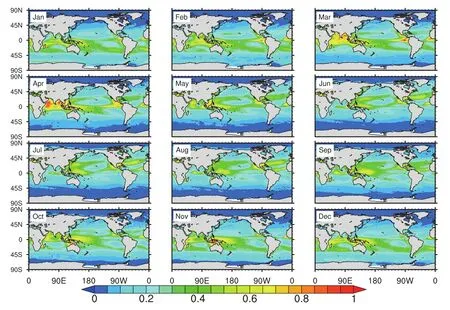
Fig.9.Averaged DSST values for each month for the entire MLSST period(1982–2012).Units:°C.

Fig.10.Time series of the normalized DSST anomaly in the Niño3 region(5°S–5°N,150°–90°W)and normalized Niño3 index using a 5-yr running mean.
The MLSST dataset provides skin SST as well as SST.The spatial patterns are similar for skin SST and bulk SST,but the DSST values from skin SST are around 0.7°C higher than those based on the bulk SST.This will help modelers to distinguish between using the skin SST and bulk SST in numerical models.
Since the temperature observations of TAO are assimilated in CFSR(Hu and Kumar,2015),the difference between the MLSST simulation and TAO buoy data is small.To make the validation more reliable,more independent SST observations should be involved in further work.Also,special attention should be paid to the mechanisms by which shortwave solar radiation and surface wind speed contribute to DSST in different regions,to improve the accuracy of the dataset and reproduce the extreme diurnal warming events.Further work should also include preparing for an operational run to generate a real-time hourly SST dataset available for public download.
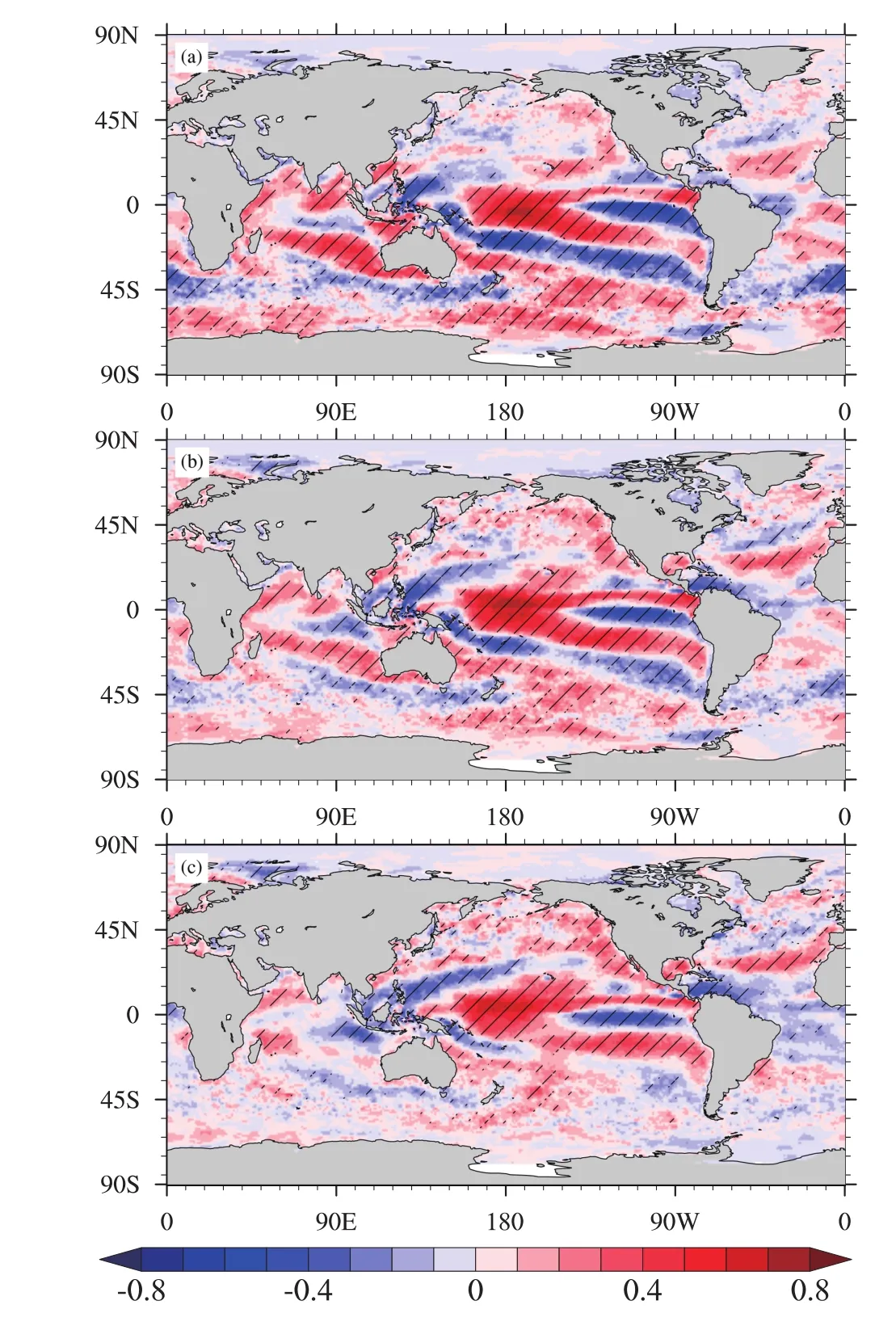
Fig.11.Lead-time correlation of DSST with the Niño3 index.The lead times are(a)0 months,(b)3 months,and(c)6 months.Hatched areas are statistically significant at the 99%confidence level.
Acknowledgements.We gratefully acknowledge the support of the National Programme on Global Change and Air–Sea Interaction(GASI-IPOVAI-06),the National Basic Research(973)Program of China(Grant No.2014CB745004),and the National Natural Science Foundation of China(Grant No.41376016).The buoy data were provided by the TAO Project Office and NDBC.The OISST data are produced by NOAA and the CFSR data are from NCEP.We appreciate the comments of the anonymous reviewers,which helped to improve the quality of this paper.
杂志排行
Advances in Atmospheric Sciences的其它文章
- Nocturnal Low-level Winds and Their Impacts on Particulate Matter over the Beijing Area
- Impact of Interannual Variation of Synoptic Disturbances on the Tracks and Landfalls of Tropical Cyclones over the Western North Pacific
- Two Types of Flash Drought and Their Connections with Seasonal Drought
- Electronic Supplementary Material to:Two Types of Flash Drought and Their Connections with Seasonal Drought∗
- Estimating the Predictability Limit of Tropical Cyclone Tracks over the Western North Pacific Using Observational Data
- Impact of Mid-and Upper-Level Dry Air on Tropical Cyclone Genesis and Intensification:A Modeling Study of Durian(2001)
